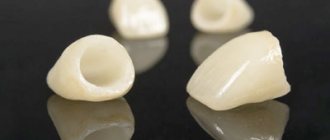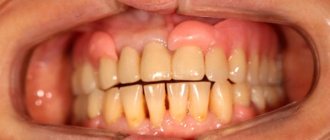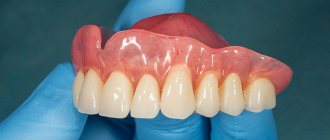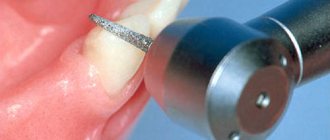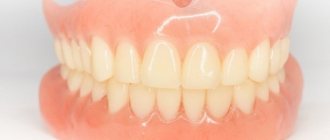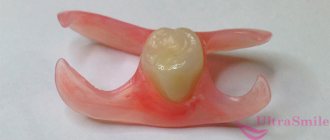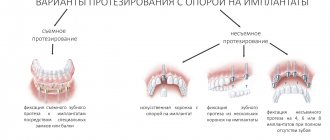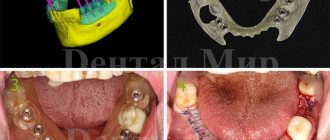Dentistry today works real miracles. Despite this, keeping teeth intact in old age is not so easy. As a rule, older people need prosthetics. At the same time, it is important to choose the right orthopedic design, since at the moment the choice of prostheses is huge. Each material and product has both its advantages and disadvantages. Therefore, it is necessary to proceed from the individual characteristics of the patient, as well as from the clinical picture of his oral cavity.
Orthopedic dentistry
Orthopedics is a large branch of dentistry that deals with the elimination of violations of the integrity and defects of the maxillofacial area. The basis of orthopedic dental treatment is prosthetics.
There are two main treatment methods :
- Dental restoration. Suitable for situations where the tooth is not completely lost. The area of the missing tooth is filled with special orthopedic structures (stump inlays, pins, etc.). Thus, the damaged dentition is restored to its original appearance.
- Prosthetics. This option is used for complete tooth loss. An orthopedic dentist selects an individual denture. There are several types of structures, differing both in the materials from which they are made and in the installation methods.
Orthopedic dentistry
Prosthetics of lower teeth
Prosthetics of the lower teeth has features related to the fact that the lower jaw is mobile, unlike the upper.
We use the lower jaw not only for chewing, but also for speech and swallowing. Incorrect prosthetics can affect pronunciation and appearance. A complete removable denture on the lower jaw is additionally secured with glue. When installing partially removable dentures, which rest on both the gums and the remaining teeth, there are no problems.
It is also possible to prosthetize the lower teeth with fixed prostheses made of cermets, non-metallic cermets, zirconium dioxide, bridges and veneers.
Dental prosthetics for pensioners
Almost every elderly person needs high-quality dental prosthetics. Many private clinics are accommodating to pensioners and very often discounts on prosthetic procedures reach 15-20%. The possibility of prosthetics should not be ignored. Having all your teeth will not only give you the opportunity to smile and chew any food, but will also solve problems with gums that have suffered increased stress.
Dental prosthetics for periodontal diseases
Periodontal disease often causes tooth loss, and it all starts with just a little bleeding from the gums. Periodontitis is caused by heredity and malocclusion. Before prosthetics, it is necessary to cure periodontal disease, and then the dentist begins to strengthen loose teeth.
Prosthetics for patients with periodontitis is a complex procedure. First, the gum tissue is restored.
Dental prosthetics for diabetes
Dental prosthetics for diabetes are required quite often, since the teeth also suffer from this disease. A patient with diabetes needs to monitor the condition of their gums. Such people need hygienic teeth cleaning once every three months.
People with diabetes today undergo dental implantation, but, taking into account their medical history, not all clinics undertake this. If diabetes is in an active uncontrolled phase, then this may become an absolute contraindication. A more gentle way is to install bridges with grinding of adjacent teeth. In recent years, bridges have begun to be installed without turning, but this method is more expensive.
Dental prosthetics for children
Prosthetics of baby teeth in children - why is it necessary? Indeed, the time will come when permanent teeth will replace milk teeth. Prosthetics of baby teeth are necessary if for some reason, usually trauma, they have been lost. If this happened before the natural change of teeth from 6 to 14 years, then the bite begins to deform, the teeth shift, and diction is impaired.
Prostheses for children are made of plastic. Their service life is about a year, as the jaw grows. An orthodontist deals with the problems of children's prosthetics.
Children can also have metal crowns installed. Indications for the use of metal crowns:
- Restoration of primary molars after treatment of pulpitis
- Restoration of teeth with congenital defects
- Dental restoration after injury
- Complications during dental prosthetics
Dental prosthetics under general anesthesia
Dental prosthetics under general anesthesia is necessary if you still have a panic fear of the dentist. But there are other cases.
There are special categories of patients who require general anesthesia even for dental treatment. Who are they?
- Patients with cardiovascular diseases
- Patients who are allergic to all (and this happens!) local anesthetics
- Patients with severe immune problems
Before dental treatment, patients must undergo examination by a cardiologist, allergist, immunologist, and endocrinologist.
General anesthesia makes the dentist's work easier as it reduces saliva production. Which also makes it more preferable in complex medical cases.
Dentures
Dentures are structures designed for full or partial restoration of the dentition. There are three types of prostheses:
- Removable;
- Fixed;
- Partially removable.
For each individual case, the orthopedic dentist selects an individual type of design. Its choice depends on many factors: the health of the patient’s body as a whole, structural features of the maxillofacial area, the presence of other oral diseases, treatment methods used in this clinic.
Innovative materials and the latest technologies in the field of orthopedic treatment allow us to achieve excellent results. The service life of modern prostheses reaches more than 10 years. They are distinguished by excellent aesthetic qualities, comfort and ease of wearing.
Artificial teeth used on modern structures are almost impossible to distinguish from natural teeth.
The development of orthopedic dentistry does not stand still; new developments and materials are constantly appearing. However, classical prosthetic methods are not excluded. Methods are emerging that combine various areas of dentistry.
For example, modern dentures are often fixed on mini-implants. Thus, the treatment uses the best practices of both implantology and orthopedics.
Dental prosthetics. Types of orthopedic structures.
Prostheses are dental structures that imitate a tooth, part or group of teeth. Modern designs for prosthetics are suitable for people of any age, they are adaptable, hypoallergenic and have a long service life.
Problems of prosthetics:
- Improving the aesthetics of the dentition
- Artistic restoration of teeth
- Complete restoration of a tooth or jaw
- Restoration of chewing function
There are several types of dentures: removable, partially removable and fixed dentures.
Fixed dentures are attached to the tooth root, adjacent teeth, and an implant screw.
- Crowns are caps on the supragingival part of the tooth, made of different materials, and can be attached to the root of your tooth or to the implant rod.
- Metal crowns last up to 20 years, are inexpensive, durable, and can cause allergies.
- Metal-ceramic crowns last up to 15 years, cost from 10,000 rubles, are durable, require grinding and depulpation.
- Ceramic crowns last up to 15 years, are suitable for restoring front teeth, do not change color, are more fragile, from 20,000 rubles.
- Zirconium dioxide crowns and aluminum oxide crowns last from 15 to 20 years, are durable, the most expensive, but also the most aesthetic.
- A bridge prosthesis, suitable if several adjacent teeth are lost, but no more than three, is attached to the adjacent teeth, put on the implant, and glued to the adjacent teeth with adhesive.
- Microprestosion: inlays, veneers, lumineers. These are dental overlays for restoring chips, cracks, and correcting tooth shape; they have a high level of aesthetics, but do not solve the problem of malocclusion. Patients often request to straighten their bite with veneers, but for a good long-term result a complex of orthodontic and orthopedic procedures is necessary.
Removable dentures.
This type of structure is fully or partially removable. Suitable for cases where there are very few or no teeth left. They can be attached due to the elasticity of the material or fixed with cream.
- Clasp dentures include a metal arch-base, a plastic frame and crowns. Most often, such dentures are used in the absence of chewing teeth. A popular type of such prosthesis is the butterfly prosthesis.
- Acrylic dentures are plastic and do not injure the oral mucosa, however, due to the characteristics of the material, they are allergenic and require special hygiene due to the growth of bacteria in the porous texture of the structure.
- Nylon prostheses are the most modern and comfortable solution; they are lightweight, hypoallergenic, flexible and the most aesthetic. However, if the atrophy of the bone tissue of the alveolar crest already exceeds 20% of its previous height, this type of prosthesis is contraindicated.
Which prosthesis to choose?
At the Orthodontist Premier clinic, patients are treated by orthopedists with over 10 years of experience. Before dental prosthetics, we conduct a thorough diagnosis of many factors before drawing up a treatment plan and choosing the type of construction. We examine indicators of the patient’s health and age, the degree of preservation of teeth, individual characteristics, financial capabilities and lifestyle. The type of prosthesis and the price of prosthetics are calculated individually, taking into account objective indicators and the wishes of the patient. Dentists guarantee long-lasting results for the prosthesis, subject to the rules of use and hygienic requirements for the design
Removable dentures
Removable dentures are structures that can be removed and installed independently. Modern dentures are comfortable to wear and have an attractive appearance, indistinguishable from real teeth.
There are two types of removable structures: clasp and plate.
According to the method of fixation, prostheses are distinguished:
- With a clasp fixation system (a clasp is a kind of hook shape);
- With fixation on attachments (on locks and hinges);
- With telescopic fixation system.
Fixed dentures
This type of prosthesis is permanently in the oral cavity. Using various fixation methods, they are securely fixed and do not require daily manipulations to remove and install them. This mounting option is most comfortable for the patient. After installing the prosthesis (provided that the procedure was performed by a competent orthopedic specialist), you can forget about it. And remember during routine dental examinations.
Non-removable structures include:
- Restorative crowns;
- Bridges.
Tab
An inlay is a microprosthesis used to replace tooth defects and restore the anatomical shape of crowns. It can serve as a support for a short bridge (the so-called Maryland bridge), a splinting structure.
Dental inlays
Indications for production:
- Pathologies of hard dental tissues that cannot be replaced by filling: caries , increased abrasion, wedge-shaped (abfraction) defects , crown fractures, enamel hypoplasia, fluorosis;
- Defects in the dentition of 1–2 teeth (as a fixing element in temporary structures with an extended service life);
- Pathological mobility of teeth (splinting elements during orthopedic treatment of periodontitis - inflammation of periodontal tissues).
Advantages of inlays over direct restorations (“fillings”):
- Elimination of incorrect cavity formation (on the model and in the tooth it will have tight, precise contact with the walls and a single direction of insertion due to steep walls and a flat bottom);
- The possibility of more accurate and correct restoration of the correct anatomical shape and individual characteristics of the crown, the functional component (chewing);
- High-quality restoration of the contact point - the part of the crown in contact with adjacent teeth (optimal shape and position, smoothness) - this is important for the healthy condition of the gums;
- Possibility of additional correction before fixation (visually, radiologically, instrumentally);
- High color stability and durability.
Restrictions and contraindications:
- Very deep and hard-to-reach cavities (submerged under the gum);
- Low natural crown.
Classification:
- Inlay – completely surrounded by hard tooth tissues;
- Onlay – cover the internal slopes of the tubercles (protective overlay);
- Overlay – covers all surfaces except one (usually the outside);
- Pinlay – reinforced into tissue using pin(s).
For the manufacture of inlays, the following are used: metal alloys (cobalt-chromium, silver-palladium, gold), composite materials, ceramic masses, zirconium oxide.
Clinical and laboratory stages of making an inlay (indirect method):
- Creation of a cavity within the enamel and dentin with preventive expansion to avoid secondary caries ;
- Obtaining impressions and models;
- Making a wax reproduction of the future design;
- Conversion into a permanent material (casting, firing, milling, pressing);
- Checking the accuracy of manufacturing on the model and in the clinic, fixation.
With the direct manufacturing method, the formation from wax occurs directly in the cavity prepared in the tooth. The indirect method is most often used.
Partially removable dentures
Partial removable dentures are made to fit a portion of the toothless jaw and are secured with discreet clasp hooks. After each meal, the denture should be removed and rinsed with running water.
Some people find it difficult to get used to removable dentures, but if you follow the tips that can be found at this link, the adjustment process will be much easier. The main advantage of removable dentures is that in order to remove or put on the denture you do not need to go to the dentist, the process of cleaning and caring for the structure becomes easier.
At the Consilium Dent dental clinic, all work on the selection, manufacture and installation of prostheses is performed by experienced orthopedic dentists who are capable of solving the most complex clinical problems.
When you contact the clinic, our doctors will make temporary prostheses on the same day, which can be used until the end of treatment. This will provide our patients with maximum comfort and help hide aesthetic imperfections.
